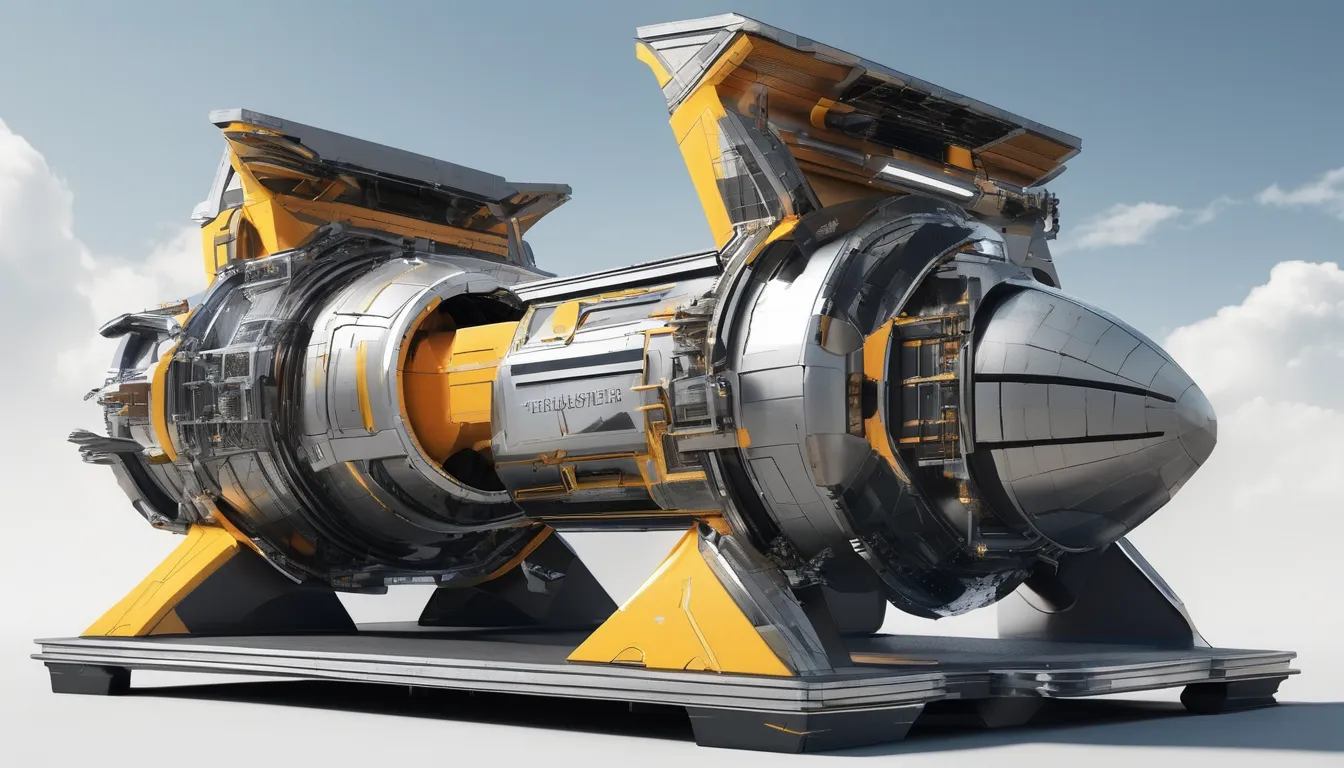You're likely familiar with the challenges of space propulsion systems – high fuel costs, limited mission durations, and inefficient fuel usage. However, with the emergence of thruster blast technology, these limitations are being reevaluated. By offering high specific impulse, this innovative technology is revolutionizing the way we approach space exploration. As you consider the possibilities of interplanetary travel, you might wonder: what exactly makes thruster blast technology so promising, and how will it shape the future of space propulsion systems? The answer lies in its unique advantages and applications.
Advantages of Thruster Blast Technology
You're about to explore the benefits of Thruster Blast Technology, and what you'll discover is impressive. One of the significant advantages of this technology is its high specific impulse, which means it can generate more thrust while using less propellant.
This results in longer mission durations and reduced fuel costs, making it an attractive option Thruster blast space missions.
Thruster Blast Technology also offers increased efficiency, as it can maintain a consistent thrust over time. This is because it uses a high-frequency electrical discharge to generate thrust, rather than relying on traditional chemical propulsion systems.
Additionally, Thruster Blast Technology is highly reliable and requires less maintenance than traditional systems, reducing the risk of system failures and downtime.
Another benefit of Thruster Blast Technology is its scalability. It can be easily integrated into various spacecraft designs, from small satellites to large interplanetary missions.
This versatility makes it an ideal choice for a wide range of space applications. Overall, the advantages of Thruster Blast Technology make it a promising solution for future space propulsion systems.
Types of Thruster Systems Available
Several types of thruster systems are available, each with its own unique characteristics and advantages. You'll find ion thrusters, which use electrical energy to accelerate ions and generate thrust. These systems are highly efficient and suitable for long-duration missions.
Hall effect thrusters are another type, operating on a similar principle as ion thrusters but with a more robust design. They're often used in Earth orbit and interplanetary missions.
You'll also come across magnetoplasmadynamic (MPD) thrusters, which utilize electrical energy to accelerate a plasma of ions and electrons. These systems are capable of producing high thrust levels, making them suitable for missions requiring rapid acceleration.
Next, there are arcjet thrusters, which use electrical energy to heat a propellant, generating a high-velocity exhaust. These systems are compact and simple, making them ideal for small satellites and short-duration missions.
Lastly, there are cold gas thrusters, which use high-pressure gases to generate thrust. These systems are simple, reliable, and suitable for short-duration missions or attitude control.
Each type of thruster system has its strengths and weaknesses, and you'll need to consider these factors when selecting the right system for your mission.
Applications in Space Missions
As space agencies and private companies continue pushing the boundaries of space exploration, they're turning to advanced thruster technologies to propel their missions forward. You're likely to see thruster blast technology play a crucial role in various space missions, from interplanetary travel to satellite operations.
For instance, NASA's Deep Space 1 and Dawn missions successfully utilized ion thrusters to propel their spacecraft. Similarly, the European Space Agency's SMART-1 mission employed a Hall effect thruster to reach the Moon.
Thruster blast technology is also being considered for future missions to Mars and beyond. The technology's high efficiency and specific impulse make it an attractive option for long-duration missions where fuel is limited.
Additionally, thrusters can be used for station-keeping and attitude control in satellites, reducing the need for traditional propulsion systems. You can expect to see more widespread adoption of thruster blast technology as space agencies and private companies continue to push the boundaries of space exploration.
This technology has the potential to revolutionize the way you travel through space, making it faster, more efficient, and more cost-effective.
Overcoming Traditional Propulsion Limitations
One major hurdle traditional propulsion systems face is their limited efficiency and specific impulse. You've likely heard that traditional systems burn a lot of fuel to achieve relatively low speeds.
This inefficiency limits the range and duration of space missions. Thruster blast technology is changing this by providing a more efficient and longer-lasting propulsion system. By using advanced materials and designs, thruster blast technology can achieve higher specific impulse and efficiency, allowing spacecraft to travel farther and stay in space longer.
Another limitation of traditional propulsion systems is their mass. You need a lot of fuel to propel a spacecraft, which adds weight and reduces the spacecraft's overall efficiency.
Thruster blast technology helps overcome this limitation by providing a more efficient use of fuel. This means that spacecraft can carry more payload and less fuel, making them more efficient and effective. With thruster blast technology, you can achieve more with less, which is a game-changer for space exploration.
Future Developments and Innovations
Next-generation thrusters are being developed to further boost the efficiency and performance of thruster blast technology.
You're likely to see advancements in materials science, such as the use of lighter, stronger materials that can withstand the stresses of high-powered thrusters. This will enable you to build more efficient and longer-lasting thrusters.
Researchers are also exploring new propellant options that can provide even higher specific impulse. You'll see the development of hybrid thrusters that combine different propellants and technologies to achieve better performance and efficiency. For example, thrusters that combine traditional chemical propellants with advanced ion or Hall effect thrusters.
Another area of innovation is in the development of advanced power systems. You'll need high-powered electrical systems to support the operation of next-generation thrusters. Advances in power conversion and energy storage will be critical to enabling the efficient operation of these systems. With these developments, you can expect to see significant improvements in the performance and efficiency of thruster blast technology, enabling more ambitious space missions and further expanding our presence in space.
Frequently Asked Questions
What Materials Are Used in Thruster Blast Technology Manufacturing?
You're looking for the materials used in manufacturing thruster blast technology. It involves high-temperature resistant materials like ceramics, refractory metals, and advanced polymers, which you carefully select and engineer to withstand extreme conditions and intense heat.
Can Thruster Blast Technology Be Used in Underwater Vehicles?
You're exploring if thruster blast technology can be used in underwater vehicles. While it's primarily designed for space, some underwater vehicles could potentially utilize this tech, but it's not widely implemented due to water's high density.
How Do Thrusters Handle Extreme Space Temperature Fluctuations?
You're probably wondering how thrusters handle extreme space temperature fluctuations. They're designed with advanced materials and insulation to maintain performance in temperatures ranging from -270°C to 120°C, ensuring consistent operation despite drastic changes.
Are Thruster Systems Compatible With Existing Spacecraft Designs?
You're likely wondering if thruster systems can be integrated into existing spacecraft designs. Fortunately, modern thrusters are often designed to be modular, allowing you to easily adapt them to various spacecraft configurations with minimal modifications needed.
Can Thruster Blast Technology Be Powered by Renewable Energy Sources?
You're exploring if thruster blast technology can be powered by renewable energy sources. Yes, it can, as you're able to harness solar or nuclear power to generate the electricity needed to fuel the thrusters efficiently.
Conclusion
You're on the cusp of a space propulsion revolution, thanks to thruster blast technology. As this innovation continues to advance, you can expect even more efficient fuel use, longer mission durations, and lower costs. With ongoing breakthroughs in materials science and power systems, the possibilities for space exploration will expand exponentially. Get ready to blast off into a future where interplanetary travel becomes increasingly feasible and the boundaries of space exploration are pushed to new limits.






